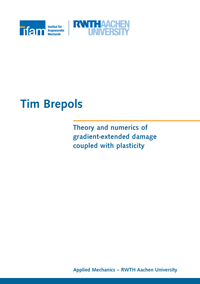
Shop : Details
Shop
Details
49,80 €ISBN 978-3-8440-6512-1Softcover288 pages83 figures428 g21 x 14,8 cmEnglishThesis
February 2019
Tim Brepols
Theory and numerics of gradient-extended damage coupled with plasticity
Numerical simulations for predicting damage and failure of materials and structures are of fundamental importance in many engineering disciplines. The significance of such simulations depends to a large extent on the quality of the applied material models which are themselves constantly being further developed to take more and more phenomena and effects into account that occur in real materials. In this context, the coupled modeling of the complex material phenomena 'damage' and 'plasticity' can be mentioned as a challenging and practically relevant subject the scientific literature has been dealing with for quite some time already. There is still a pressing need for further research in this scientific field.
br> The overall goal of the present dissertation is the development and investigation of novel gradient-extended damage-plasticity material models, both for the geometrically linear and nonlinear regime, which are based on a so-called 'two-surface' approach. The latter means that damage and plasticity are modeled as truly distinct (but coupled) dissipative mechanisms by taking separate damage loading and plastic yield criteria as well as loading / unloading conditions into consideration, respectively. Nonlinear Armstrong-Frederick kinematic hardening, nonlinear Voce isotropic hardening and nonlinear damage hardening are also accounted for by the models that can quite flexibly be adapted to various situations in which the considered real material shows either a (quasi-)brittle-type, ductile-type or possibly a mixed-type damaging behavior. The gradient-extension of damage is used to avoid pathological mesh sensitivity issues in finite element simulations that otherwise typically occur when using conventional models involving material softening behavior.
br> The overall goal of the present dissertation is the development and investigation of novel gradient-extended damage-plasticity material models, both for the geometrically linear and nonlinear regime, which are based on a so-called 'two-surface' approach. The latter means that damage and plasticity are modeled as truly distinct (but coupled) dissipative mechanisms by taking separate damage loading and plastic yield criteria as well as loading / unloading conditions into consideration, respectively. Nonlinear Armstrong-Frederick kinematic hardening, nonlinear Voce isotropic hardening and nonlinear damage hardening are also accounted for by the models that can quite flexibly be adapted to various situations in which the considered real material shows either a (quasi-)brittle-type, ductile-type or possibly a mixed-type damaging behavior. The gradient-extension of damage is used to avoid pathological mesh sensitivity issues in finite element simulations that otherwise typically occur when using conventional models involving material softening behavior.
Keywords: coupled damage-plasticity; finite strains; gradient damage; mesh regularization; micromorphic approach
Available online documents for this title
You need Adobe Reader, to view these files. Here you will find a little help and information for downloading the PDF files.
Please note that the online documents cannot be printed or edited.
Please also see further information at: Help and Information.
Please also see further information at: Help and Information.
| Document |  | Document | ||
| Type |  | |||
| Costs |  | 37,35 € | ||
| Action |  | Purchase in obligation and download the file | ||
| Document |  | Table of contents | ||
| Type |  | |||
| Costs |  | free | ||
| Action |  | Download the file | ||
User settings for registered online customers (online documents)
You can change your address details here and access documents you have already ordered.
User
Not logged in
Export of bibliographic data
Shaker Verlag GmbH
Am Langen Graben 15a
52353 Düren
Germany
Am Langen Graben 15a
52353 Düren
Germany
Mon. - Thurs. 8:00 a.m. to 4:00 p.m.
Fri. 8:00 a.m. to 3:00 p.m.
Fri. 8:00 a.m. to 3:00 p.m.
Contact us. We will be happy to help you.



